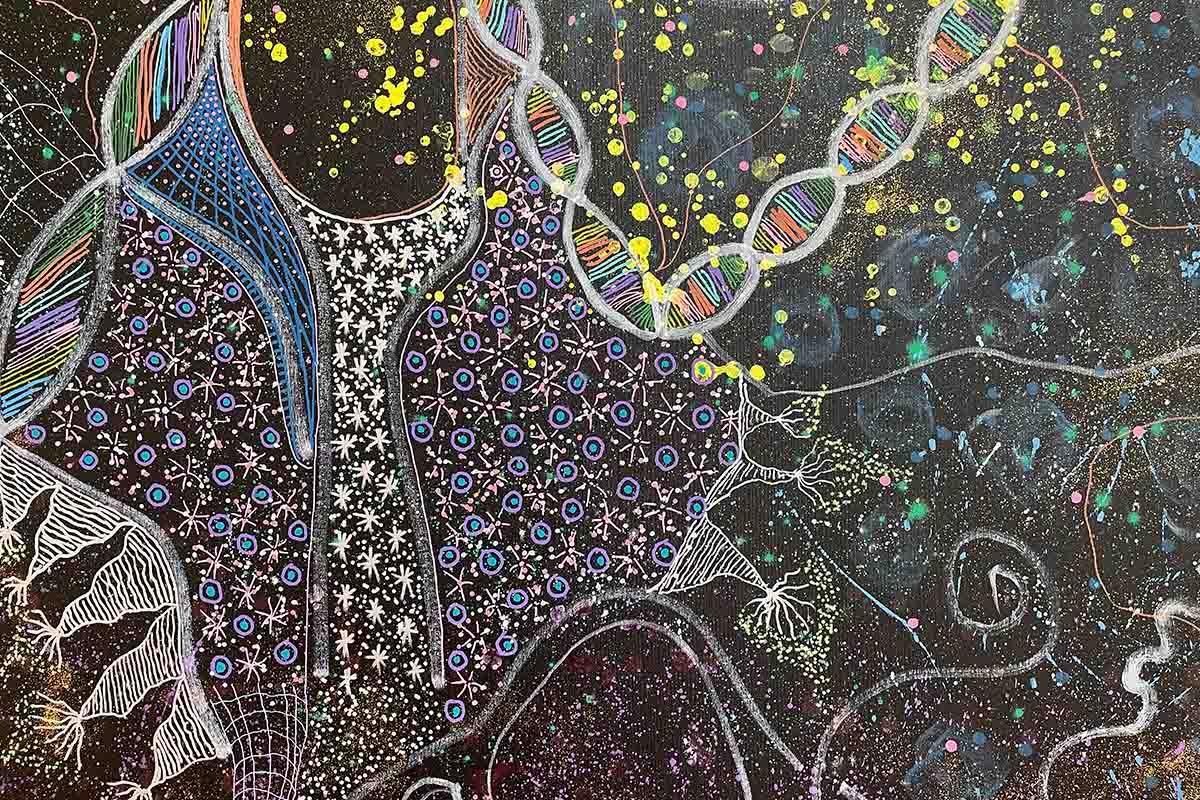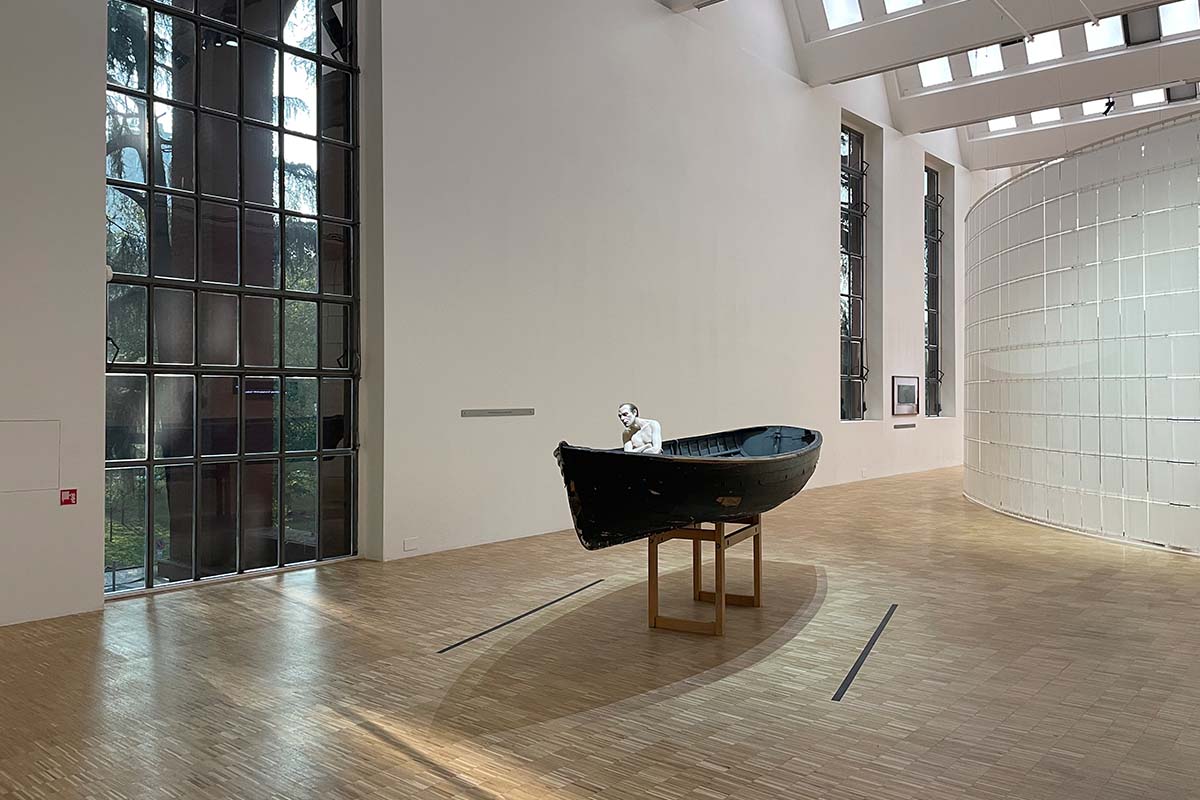Mondo Reale at Triennale Milano: a witty encounter with Formafantasma and Hervé Chandès at The Fondation Cartier, an attempt to disentangle complexities
Fondation Cartier – Mondo reale
Mondo Reale is an exhibition by The Fondation Cartier pour l’art contemporain presented in Milan from July 15 to December 11, 2022 as part of the 23rd Triennale International Exhibition Unknown Unknowns. The title is taken from an artwork presented in the first segment of the exhibition entitled ‘Mondo Reale: Stop, look and listen’ (2022) by Brazilian artist Alex Cerveny.
In his painted personal glossary, the artist maps out landscapes of natural and biblical events as well as names of places and people that create his world. In the center of the exhibition hangs Mondo Reale (2022) which is also the title of a drawing by French illustrator Yann Kebbi. Behind this multilayered interpretation of the real world into different forms and contexts stands Hervé Chandès, the General Director of Fondation Cartier.
Chandès expands on the meaning of the exhibition’s title further: «this is the world that we breathe, live in and we don’t know any other». Chandès has been leading Fondation Cartier for almost thirty years and constantly reinvents the foundation as a «free, transversal and open space», remaining faithful to the original objectives of the cultural institution nested in Jean Nouvel’s translucent edifice on Boulevard Raspail in Paris.
About the complexities and absurdities of our world today
In an attempt to disentangle some of the complexities and absurdities of our world today, «the selected artists display ways to understand events of our shared now, through films, paintings, photographs, ceramics, instal- lations and sculptures» added Chandès. Mondo Reale exhibits seventeen international contemporary artists and the exhibition design was entrusted to the Milanese design studio Formafantasma. Chandès explained: «There are no proper strategies when we develop an exhibition, rather we try to engage with desires and playfulness, that’s when the exhibition emerges, along with the work of many people who work on it for months and years».
An example of this playfulness is how Chandès used the artwork checklist (the inventory of all the artworks, dimensions, potential groupings as well as optimal climatic conditions or specifications for displaying each work). This checklist is usually only shared with the exhibition design team, allowing them to articulate the artworks in space. While Formafantasma worked with this checklist, artist Kebbi was invited by the foundation to conceptualize a parallel version of the exhibition «through the filter of his creativity».
The vision overlapping – a dialogue between reality and fiction
Kebbi drew the exhibition as he imagined it. His drawing shows the artworks from the checklist in a fictional green landscape, positioned on Oscar Niemeyeresque white platforms. In his artwork, Kebbi displays the large-scale photographs of Jessica Wynne in sheer proximity to the somber stilts of the film Nature (2020) by Artavazd Pelechian (both displayed in this exhibition). In pure coincidence, the Mondo Reale painting of Ceverny hangs with cables in both Kebbi’s speculative drawing as well as in the final exhibition design by Formafantasma.
Andrea Trimarchi from Formafantasma highlights this overlap of vision as «a moment where exhibitions become dialogues between reality and fiction». Chandès added that this «mise en abyme between both interpretations
of the checklist is what we try to do at Fondation Cartier, there is an urge to be playful and explorative».
A recent work of Formafantasma was featured in the Metamorphosis, Art in Europe Now (2019) show at Fondation Cartier in Paris. Trimarchi add- ed: «many of the issues addressed in Metamorphosis are still valuable to look into today». Trimarchi also explained the process of developing their design for Mondo Reale as «trying to respond to an apparently simple question: what is reality in the context of a fabricated exhibition?». The design reuses the walls that were built for the previous exhibition instead of working with additional plastered walls «a synonym for ephemerality» he continued.
Trimarchi describes the space as «a series of pavilions, from one side capable of creating smaller cocoons where visitors can focus on the singular element while allowing permeability and creating connections between the different artworks. Three paper walls were made from the Japanese paper Takeo, allowing for slightly curved partitions that frame paintings and become backdrops to Sarah Sze’s Tracing the Falling Sky or they host movies while allowing natural lighting in».
An exhibition linked to senses and observations
The exhibition brings together artists, mathematicians, physicists, and philosophers; they all act «a bit like detectives would» highlighted Chandès. He cited David Lynch’s film, What Did Jack Do? (2017) which is featured in the exhibition. The black-and-white thriller is set in a train station, where a homicide squad detective played by Lynch corners a suspect.
«The visitor is a disoriented explorer in an investigation room, trying to understand the events around». Trimarchi expanded on this idea «at the core of the first pavilion, we assembled a staircase made of extruded industrial profiles to give Andri Ujica’s film Unknown Quantity a new way of being investigated. The video was conceived as a conversation filmed by a CCTV camera, from an elevated perspective, and the exhibition design aims to bring visitors to that level including them in the scene».
The materiality behind the work of Formafantasma
Chandès describes this exhibition as «deeply linked to senses and observations». He adds «the materiality behind the work of Formafantasma is also what makes this exhibition respond to the realities of today». The materials used are mostly borrowed or recycled, and include wood, bricks, metal scaffoldings, and wool carpets. The benches around the work of Lynch and Wynne are made of construction concrete blocks topped with a stainless steel sheet.
Chandès illustrates «if you decide to punch the bench you are sitting on, you will feel its materiality, a parallel with the research and physicality of the series of large-scale photographs by Jessica Wynne, who presents blackboards bearing writings by scientists of contemporary times, here physicist Carlo Rovelli. The materiality of the blackboard lies between knowledge production and its constant erasure and rewriting». This work also enters in dialogue with the video by Jean-Michel Alberola, La Main de Cédric Villani, which captures the gestures of the mathematician on his blackboard. «Exhibitions are invitations. When they work, they become invitations to dream, to stop and think» Chandès spells out.
Exploring Mondo Reale through captions
Another route through which a visitor enters this playful invitation is the captions. Debates occur usually between the exhibition design, graphic design and curatorial teams on the materiality of the captions, the length of the text or the font used. In most exhibitions, the caption system translates into a fairly small contained book-sized panel. Here the system is «designed to become a key element strongly linked to the artworks. The captions are made of over a meter long plates that host the essential information for the visitors», explained Trimarchi. These captions «allow for a lot of exploration, they take you from one work to another and create a rich movement and rhythm within the exhibi- tion», added Chandès.
In recent years, Fondation Cartier has expanded with branches in Lille, Milan and Shanghai. Across the different contexts, the foundation aims to «revisit, re-explore and reinvent for different audiences. When we open a show in Shanghai, we enjoy incorporating artists of the region, to speak to an even larger audience. It is also a way for us to constantly push ourselves and our desire to foster a culture of cultures», explained Chandès. It will be interesting to follow the trajectories of Mondo Reale, as a title, an exhibition and an ethos will take in its different contexts. The foundation has honed this capacity in its exhibitions, public pro- grams, and publications which display problems that shape our ‘crisis as usual’ world of today.
Fondation Cartier
The Fondation Cartier pour l’Art Contemporain, known as the Fondation Cartier, is a contemporary art museum located at 261 boulevard Raspail in the 14th arrondissement of the French capital, Paris.




















